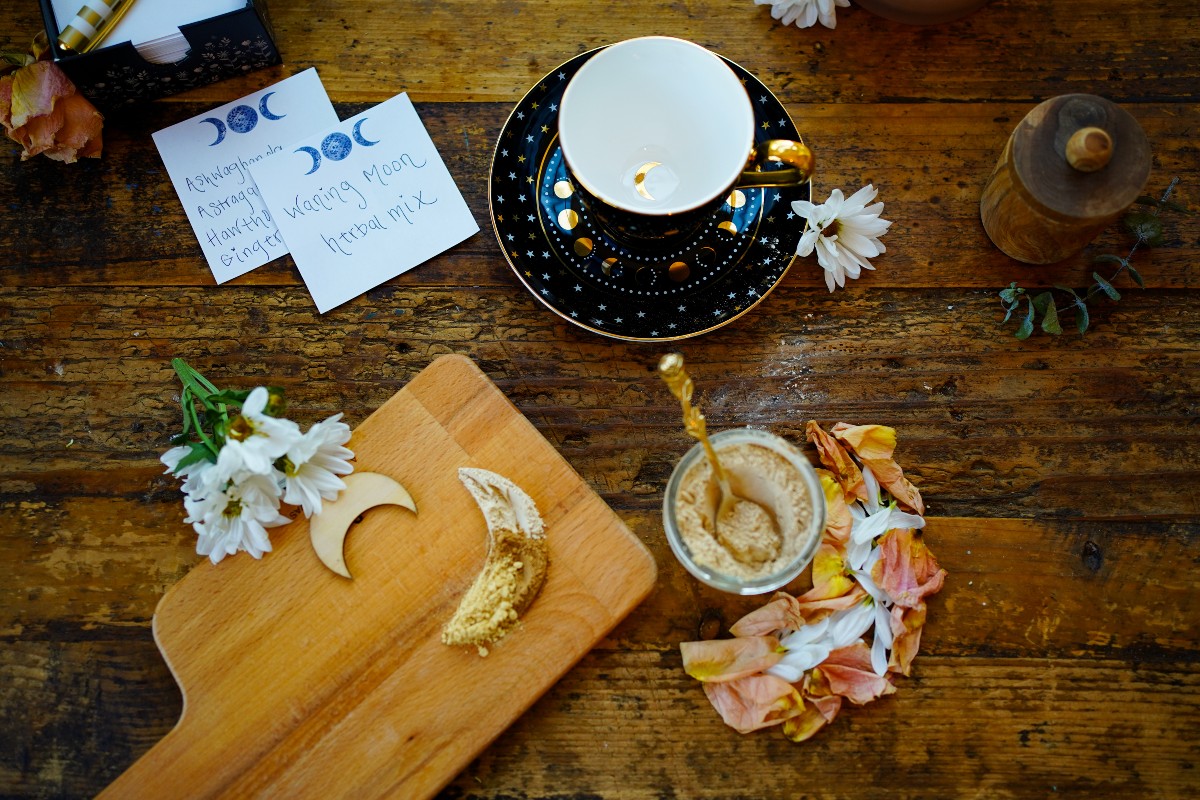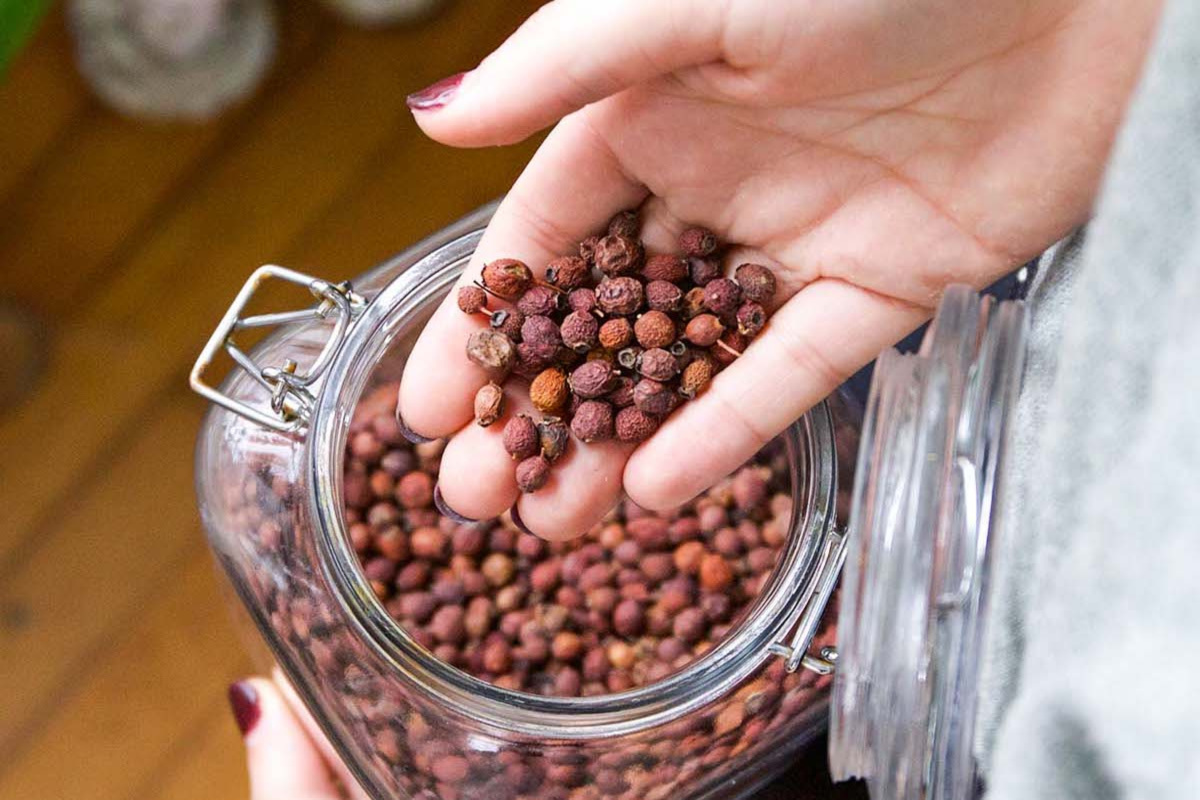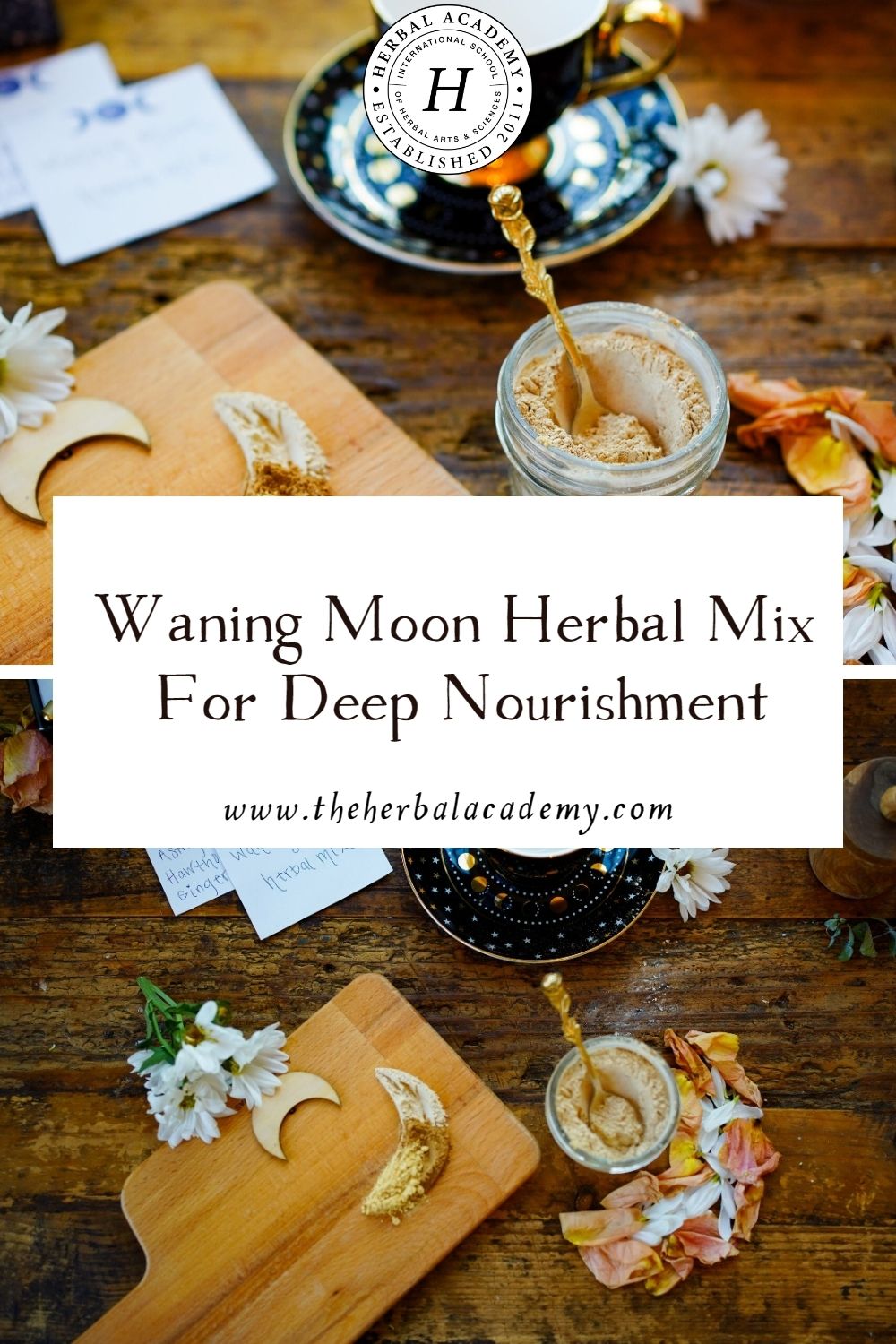
Waning Moon Herbal Mix For Deep Nourishment
When you observe the flow of your energy cycles during any given month you may notice that your energy ebbs and flows. Sometimes you need to hang out in an eddy; other times you are flowing forward at full force. During any lunar cycle, we tend to have times of heightened creativity, activity, and extroversion (often corresponding to the Waxing Moon and Full Moon) and other times when we feel the need to slow down, do less, and turn inward.
The Waning Moon phase—the time in between the Full Moon and New Moon is associated with darkness, introversion, going underground, rest, the end of the life cycle, vata dosha, and the autumn harvest. Rather than swimming upstream against the waning energies of this phase of the lunar cycle, it can be helpful to understand the energetics of the Waning Moon phase and to learn to work with this time to support our bodies and minds. In this article, I will share a recipe to embrace this time of rest and slowing down with herbs that provide deep nourishment.

Energies of the Waning Moon
Though the Waning Moon phase, sometimes referred to as the dark phase of the Moon, may not always feel like our most productive or effervescent time, it is an important and inevitable aspect of the lunar cycle. Just as fruit needs to ripen and drop its seeds so that new plant life can be born, this time can be likened to the destruction of the old which gives way to the new. “It is at this point that we enter into the dark moon phase…This process is called transformation, a process that occurs whenever any life form has fulfilled its purpose and used up its store of vital energy” (George, 1992, p. 24).
We experience the dark phase of the Moon monthly when the brilliant light of the Full Moon gradually dwindles into the darkness of the New Moon. However, we can also draw metaphoric connections between the phases of the Moon and times of life. In terms of plant growth cycles, the New Moon can be likened to planting seeds, the Full Moon to flowering, and the early Waning Moon to bearing fruit (Elenbaas, n.d.). Furthermore, during the course of our own lives, times that are characterized by loss, deconstruction, closure, reevaluation, and turning inward can be likened to the latter part of the Waning Moon phase or the dark Moon phase (George, 1992). Though peak moments where life is in full bloom can be exciting, celebratory, and even ecstatic, these are not phases that last forever, just as the Moon doesn’t always stay full from our vantage point here on Earth.
Whereas the Waxing Moon phase is a yang time, the Waning Moon phase is a yin time and may be related to questioning and contracting. We may also find that our energy is a little lower during the Waning Moon phase and for this reason, it may be wise to keep our calendars a touch lighter during these lower energy times (Elenbaas, n.d.). We can support ourselves by adjusting our workload and activities (when and where possible) and calling upon nourishing, tonifying herbs to further bolster this time of transformation as we journey into the depths of the dark Moon phase.
Herbs for the Waning Moon

Ashwagandha (Withania somnifera) root
Considered a rasayana in Ayurveda, ashwagandha (Withania somnifera) root is an excellent herb for providing deep nourishment all around. This starchy root has become popular in recent years as a nervine and adaptogen and is known for its capacity as an anti-inflammatory, muscle tonic, and sleep aid as well. Ashwagandha especially benefits the reproductive, nervous, and respiratory systems (Dass, 2013). If you are having trouble sleeping soundly, if your energy is a little low, or if you feel you need an all-around boost, ashwagandha is your friend. This nourishing root is perfect for giving broad-spectrum support during times of depletion. For more on ashwagandha, you may want to read the article The Beginner’s Guide to Ashwagandha.
Astragalus (Astragalus mongholicus) root
Astragalus (Astragalus mongholicus) root is a personal favorite when I feel a cold coming on or an overall sense of depletion—that feeling when you are rundown and teetering on the edge of sickness. Herbalist Maria Noel Groves (2016) points out that astragalus functions (and pairs well with) beneficial mushrooms in that it supports the immune system and helps stave off infection. Furthermore, astragalus functions as an adaptogen and benefits the cardiovascular system, liver, and kidneys (Groves, 2016). Add astragalus powder or sliced root to soups and broths—or enjoy as an ingredient in this Waning Moon mix recipe below.

Hawthorn (Crataegus spp.) berry
Hawthorn (Crataegus spp.) berry is added to this Waning Moon blend for its heart-supportive qualities, both physically and emotionally. As we transition into the dark phase of the Moon, feelings of sadness and grief may surface. Hawthorn gladdens the heart and soothes the nervous system while also supporting the physiological aspects of the heart—the heart muscle and circulatory system—in profound ways. “This thorny shrub-tree improves every aspect of cardiovascular health, working from various angles to fight oxidative stress, reduce inflammation, prevent and reverse blood vessel damage, relax and tone the blood vessel lining, reduce high blood pressure, improve circulation, and strengthen the heart muscle itself” (Groves, 2016, p. 153). The heart-supportive qualities of hawthorn complement the immune-boosting and overall-nourishing aspects of the other herbs in this blend.
Ginger (Zingiber officinale) rhizome
What’s not to love about ginger?! Ginger (Zingiber officinale) rhizome is known in Ayurveda as vishwabhesaj or “universal medicine” (Dass, 2013). Aside from being a tasty addition to numerous foods and beverages including masala chai, ginger cookies, and any number of soups and stir fries, ginger boosts circulation, assists digestion, quells nausea, and functions as an anti-inflammatory. Ginger is included in this blend to help digest the heaviness of the tonifying herbs, chiefly ashwagandha and astragalus. Though this Waning Moon mix is not an ayurvedic preparation per se, it is common practice in ayurvedic herbalism to include at least one digestive herb in a blend to help digest and absorb the other herbs. In addition, ginger adds a warming boost from the inside out and helps with optimal absorption of the other herbs.

This easy herbal recipe is made with dried, ground herbs and is enjoyable in hot water, hot milk, as an electuary, or mixed into smoothies and porridges. Enjoy this tonifying mix during the Waning Moon phase or any time your body, mind, and/or immune system needs a little bolstering. This recipe specifies the amounts in parts. A part can be anywhere from a teaspoon to a ¼ cup.
4 parts ashwagandha (Withania somnifera) root, groundWaning Moon Herbal Mix For Deep Nourishment
2 parts astragalus (Astragalus mongholicus) root, ground
2 parts hawthorn (Crataegus spp). berry, ground
1 part ginger (Zingiber officinale) rhizome, ground
To Use:
Take 1 teaspoon in a mug of just boiled water or warmed milk 1-2 times per day. Or, add a teaspoon to smoothies and porridges. This Waning Moon mix also makes a lovely herbal electuary.
In Closing,
You may find that you have an affinity for certain phases of the lunar cycle just as you may favor certain seasons of the year. Perhaps you adore the brilliance of the Full Moon or relish in the dark quiet of the New Moon. For some, the Waning Moon phase can bring about feelings of sadness or melancholy as the light of the Moon diminishes. However, as we become more aware of the ebbs and flows of our energy as they correspond with lunar influences, it can become easier to accept the impermanence and shifting nature of life.
As author and astrologer Demetra George (1992) points out, “The dark becomes frightening and destructive only when we deny and disown it” (p. 54). And, as the great Dumbledore so famously said in J.K. Rowling’s Harry Potter, “Happiness can be found, even in the darkest of times, if one only remembers to turn on the light.”

REFERENCES
Dass, V. (2013). Ayurvedic herbology: East & West. Lotus Press.
Elenbaas, A. (n.d.) Herbs for the decreasing moon. https://www.skyhouseherbs.com/blog/astrology-and-herbs-for-the-decreasing-moon
George, D. (1992). Mysteries of the dark moon: The healing power of the dark moon goddess. Harper Collins.
Groves, M.N. (2016). Body into balance: An herbal guide to holistic self-care. Storey Publishing.








